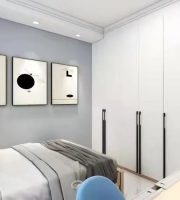Technical Specification for Safety of Steel Pipe Scaffolding with Couplers in Construction.
Measures for Safety Management of Sub projects with High Risk.
This project takes into account the construction period, quality, safety, and contract requirements. Therefore, when selecting a plan, the following points should be fully considered:.
(1) The structural design of the frame strives to achieve safety, reliability, and reasonable cost..
(2) Under specified conditions and within the specified service life, it can fully meet the expected safety and durability..
(3) When selecting materials, strive to achieve common, universal, reusable, and easy maintenance and repair..
(4) When selecting structures, efforts should be made to ensure clear stress, adequate structural measures, convenient lifting and dismantling, and easy inspection and acceptance..
Based on the above scaffolding design principles, fully considering the actual situation of this project, and taking into account past construction experience, and after multiple studies and discussions, this project adopts a floor standing scaffolding construction plan..
(1) Familiar with drawings, organize design disclosure work, and learn relevant standards and regulations..
(2) Collect, organize, and learn technical information related to scaffolding engineering..
(3) Learn and discuss construction methods and precautions for key areas..
(4) Determine the construction plan, construction method, and erection process..
The strength grade of steel is Q235-A. The surface of the steel pipe should be straight and smooth, without cracks, layering, indentation, scratches, or hard bends. The steel pipe must be coated with anti rust paint and drilling is strictly prohibited. The deviation between outer diameter and wall thickness shall not exceed 0.5mm; The two ends of the steel pipe should be flat, and the deviation should not exceed 1.7mm. Newly used steel pipes must have a factory certificate of conformity. Before scaffolding construction, the steel pipes entering the site must be sampled and sent to a testing unit with relevant national qualifications for mechanical tests such as bending and tensile strength of the steel pipes. Only after the test results meet the design requirements can they be used in construction..
The installation of the steel pipe scaffold in this project shall use malleable cast fasteners, which shall comply with the requirements of JGJ22-85 “Steel Pipe Scaffold Fastener Standard” issued by the Ministry of Construction. The fasteners shall be provided by a manufacturer with a fastener production license, and shall not have forging defects such as cracks, air holes, shrinkage and sand holes. The specifications of the fasteners shall match the steel pipe, and the bonding surface shall be flat, with flexible moving parts. The minimum distance from the opening when clamping the steel pipe shall not be less than 5mm. When the tightening torque of the steel pipe bolt reaches 65N. m, it must not be damaged. When using old fasteners, samples must be taken and sent to a testing unit with relevant national qualifications for testing the anti slip force of the fasteners. The test results must meet the design requirements before they can be used in construction..
Before setting up the scaffolding, maintenance, rust removal, and uniform color coating should be carried out, with the color striving for a beautiful environment. Scaffolding poles, protective railings, and kickboards are uniformly painted in yellow, while shear braces are uniformly painted in orange red. The bottom row upright poles and sweeping poles are painted in red and white alternating colors..
The use of scaffold boards and scaffold pieces meets relevant requirements. 50mm thick pine scaffold board is used, with a length of 2-6m and a width of 23-25cm. Both ends of the scaffold board should be tied with two clamps of 4mm thick galvanized steel wire. Scaffolding boards shall not use boards with cracks, decay, diagonal tension, or large transverse joints..
The safety net adopts a dense mesh safety net, which should meet the mesh size of 2000 mesh/100cm2. It should undergo a penetration resistance test without penetration, and a single net with a weight of 1.6 x 1.5m should have a weight of 3.


